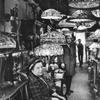Civil War drawing by Winslow Homer at New York's Gavin Spanierman
- NEW YORK, New York
- /
- April 20, 2011

Nearly twenty years after the end of the Civil War, Clarence Clough Buel and Robert Underwood Johnson, editors at Century Magazine, a monthly publication popular in the 19th and early 20th century, proposed a series of articles written by surviving participants from both sides of the conflict, North and South. The "Century War series" ran from 1884-1887 and proved to be so popular that the magazine's publishers decided to anthologize it. The publication also featured more than a thousand maps, engraved portraits, and other original artwork created by some of America's top illustrators and field correspondents, including Winslow Homer (1836-1910), Julian Oliver Davidson (1853-1894), Henry Alexander Ogden (1856-1936), Isaac Walton Taber (1857-1933), and Alfred Rudolph Waud (1828-1891).
Defense of the Baggage Train is among a group of drawings that Homer did in the service of the Century Magazine for Battles and Leaders of the Civil War. Only some of these articles, with their illustrations, were reprinted as chapters in the four volume set. Homer created fifteen illustrations for the publication, of which eleven are located today. The drawing that most closely relates to Defense of the Baggage Train is titled Baggage Guard, and was published in the February 1888 issue. The similarities in subject and detail between Defense of the Baggage Train and Baggage Guard are so closely related that it may be presumed to have been a variant version not used for the magazine illustration, but one Homer found worthy of keeping for himself.
Homer's style of illustration for the Century Magazine is distinctive due to the usage of sharp black lines, which were used specifically for the photo mechanical process of reproduction for the magazine. Uniquely, these drawings, though created in 1887-8, are back dated as to appear to have been created in the 1860's to better associate with the article they accompanied. They were reproduced from a recombination and repetition of the field sketches he did in 1862, 1864, and 1865. Many of those field sketches survive today in the Cooper Hewitt collection.
Gavin Spanierman, ltd.
1044 Madison Avenue
New York, NY 10075
p: (212) 249-0619









100x100_c.jpg)





